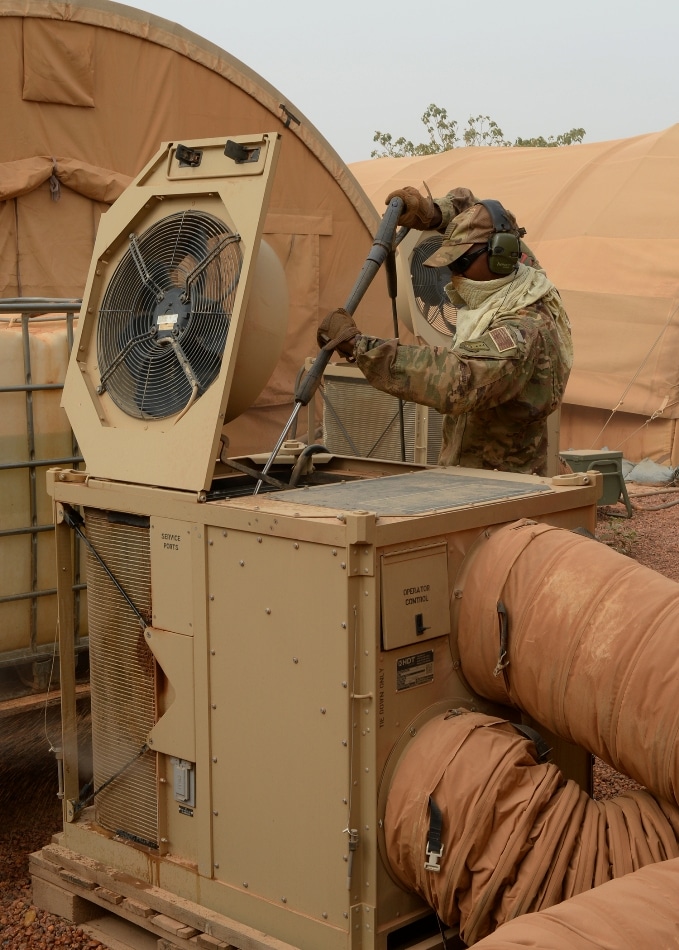May 31 2019
According to a new computational study conducted by the National Institute of Standards and Technology (NIST), over a dozen chemical blends could work as substitute refrigerants that will not heat the atmosphere as much as present-day refrigerants do, or catch fire.
 A heating, ventilation and air-conditioning (HVAC) unit gets a cleaning at an Air Force base in Nigeria. (Image credit: Jimmie Pike/U.S. Air Force)
A heating, ventilation and air-conditioning (HVAC) unit gets a cleaning at an Air Force base in Nigeria. (Image credit: Jimmie Pike/U.S. Air Force)
The NIST research identified the 22 “best” nonflammable or slightly flammable blends with lower global warming potential (GWP)—a measure of the amount of heat a gas will trap if discharged into the atmosphere—than the existing standard refrigerant for vehicle air conditioning (AC), called R-134a (tetrafluoroethane).
A majority of the identified blends integrate R-134a with one or two other refrigerants in the market.
The latest NIST analysis, which was carried out for the U.S. military but also applies to civilian applications such as AC systems for cars and homes, is a continuation to a 2017 NIST study that found that all single-component, climate-friendly refrigerants were at least slightly flammable. That study recommended blends might offer ideal solutions.
The military is insistent about wanting non-flammable blends, but the civilian applications are moving more and more toward at least marginally flammable mixtures.
Ian Bell, Study Lead Author and Mechanical Engineer, NIST
To help decrease global warming, approximately 200 countries, including the United States, agreed in 2016 to amend the Montreal Protocol to phase down by mid-century the refrigerants used in a majority of AC systems. The partial phasedown, instead of a total phaseout, recognized the difficult choices that will need to be done to choose replacements.
For the new research, NIST scientists chose 13 fluids within a range of flammability, pressure, and GWP values that might create a blend with the preferred features. All fluids were low in toxicity and available in the market. The team performed a widespread evaluation of all conceivable combinations of two or three of the 13 fluids.
The fluids included hydrofluoroolefins, which possess very low GWP but are slightly flammable; nonflammable hydrofluorocarbons (HFCs) with moderate-to-high GWP; slightly flammable HFCs; and carbon dioxide, which is nonflammable and also has a very low GWP of 1, but would increase the operating pressure of a blend, which is unwanted.
NIST scientists could not identify any blends that matched all preferred constraints — high efficiency (cooling per unit of work), low GWP, nonflammability, and total cooling capacity like that of the R-134a baseline system.
The research identified 14 nonflammable blends that delivered a reduction in GWP of, at most, 51% compared to R-134a’s GWP of 1300. An extra eight blends that were slightly flammable were identified with GWP reductions of as much as 99%. Scientists replicated the performance of these 22 blends in a comprehensive refrigeration cycle model. The study was carried out using computational tools; scientists plan to perform laboratory experiments to confirm the results.
The study showed a number of trends. The most favorable nonflammable blends have marginally lower efficiency compared to R-134a. These nonflammable blends possess a lower GWP limit of 640; this is because of the need for a lot of R-134a in the mixture to overpower the flammability of low-GWP fluids. Other blends comprising of a substantial amount of carbon dioxide were also nonflammable, but these had extremely low efficiencies compared to R-134a and were not considered feasible replacements.
There is also a basic trend of efficiency growing together with GWP and flammability. This is because lower-GWP fluids are inclined to be more complex molecules and this complexity can hamper refrigeration performance.
“The ‘good’ blends that we found are very borderline nonflammable,” Bell cautioned. “That doesn’t mean that they won’t still burn given the right environment. We need to be cautious, because this is sort of a dark art. There is a fundamental trade-off: If you really want nonflammability and efficiency, you won’t get both. You will get one or the other.”
The research received support from the U.S. Department of Defense.